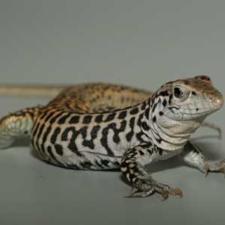When most people think about reproduction it involves both a male and a female. Agreeably, in the animal kingdom the more common form of reproduction is sexual reproduction. However, we must not forget about the species that reproduce through asexual reproduction! This phenomenon is unique but existing. The most commonly known animal that reproduces unisexually is the whiptail lizard, or the “racerunner”, which is native to southwestern US and Mexico.
Teiidae is the family of these lizards, in which there are the parthenogenetic genera Cnemidophorus and Aspidoscelis, and the non-parthenogenetic Tupinambis. There are many different species of the whiptail lizard but I will be examining the parthenogenetic genus’s mentioned above.
‘The word parthenogenesis comes from the Greek παρθένος, parthenos, meaning “virgin”, and γένεσις, genesis, meaning “birth”.’ Parthenogenesis occurs naturally in nature, seen in about 80 different animals. Invertebrate species such as water fleas, scorpions, and some bees, have developed this behavior as well as vertebrate species including some fish, amphibians, reptiles, and very rarely in certain bird species.
In parthenogenesis, asexual reproduction is performed by two females laying amniotic eggs unfertilized by males that grow and develop into usually female young. Parthenogenetic offspring typically have the diploid chromosome number, having doubled the mother’s chromosomes, essentially being a genetic clone of their mother. Ovulation is enhanced through creating more eggs by female-female courtship rituals similar to behaviors displayed by closely related species that reproduce sexually. The lizard on the bottom has larger eggs while the top lizard has smaller eggs, switching off each mating season.
It is thought that this unique mating was forced on the whiptail lizard and other parthenogenetic species due to genetic isolation from the male. Some species such as the Komodo dragon or hammerhead shark do this as necessary, but the whiptail lizard doesn’t have such a choice. Genetic studies suggest that these unisexual species developed from two sexually reproducing lizards of closely related species. Usually when two different species mate and create a hybrid the offspring is sterile. However, the hybrid offspring had mutations needed for parthenogenesis. Recently, scientists created their own species of all-female, self-cloning lizards in a lab by making a hybrid between two existing species, therefore proving these unisexual lizards developed through hybridization.
Asexual reproduction “can have questionable genetic outcomes unless done right” but it has benefits too, says Baumann. “You’re greatly increasing the chances of populating a new habitat if it only takes one individual,” he says, citing the example of the brahminy blind snake, another parthenogenetic species. “If she has a way of reproducing without the help of a male, that’s an extreme advantage.”

Works Cited:
Harmon, Katherine. “No Sex Needed: All-Female Lizard Species Cross Their Chromosomes to Make Babies: Scientific American.” No Sex Needed: All-Female Lizard Species Cross Their Chromosomes to Make Babies. Scientific American, 21 Feb. 2010. Web. 05 Dec. 2012. <http://www.scientificamerican.com/article.cfm?id=asexual-lizards>.
Keim, Brandon. “All-female Lizard Species Created in the Lab.” Ars Technica. N.p., 4 May 2011. Web. 05 Dec. 2012. <http://arstechnica.com/science/2011/05/all-female-lizard-species-created-in-the-lab/>.
“Parthenogenetic.” BBC News. BBC, n.d. Web. 05 Dec. 2012. <http://www.bbc.co.uk/nature/adaptations/Parthenogenesis>.
University of Iowa. “Value of sexual reproduction versus asexual reproduction.” ScienceDaily, 25 Jan. 2010. Web. 5 Dec. 2012.



Leave a comment